Dacia Duster vs Hyundai Bayon – Which model is better for everyday use?
Two cars, one duel: Dacia Duster meets Hyundai Bayon.
Which one wins in performance, efficiency and value for money? Find out now!
Costs and Efficiency:
When it comes to price and running costs, the biggest differences usually appear. This is often where you see which car fits your budget better in the long run.
Dacia Duster has a noticeable advantage in terms of price – it starts at 16300 £, while the Hyundai Bayon costs 20100 £. That’s a price difference of around 3780 £.
Fuel consumption also shows a difference: Dacia Duster manages with 4.70 L and is therefore to a small extent more efficient than the Hyundai Bayon with 5.40 L. The difference is about 0.70 L per 100 km.
Engine and Performance:
Power, torque and acceleration are the classic benchmarks for car enthusiasts – and here, some clear differences start to show.
When it comes to engine power, the Dacia Duster has a noticeable edge – offering 158 HP compared to 100 HP. That’s roughly 58 HP more horsepower.
In acceleration from 0 to 100 km/h, the Dacia Duster is noticeable quicker – completing the sprint in 9.40 s, while the Hyundai Bayon takes 11.30 s. That’s about 1.90 s faster.
In terms of top speed, the Dacia Duster performs minimal better – reaching 180 km/h, while the Hyundai Bayon tops out at 179 km/h. The difference is around 1 km/h.
There’s also a difference in torque: Dacia Duster pulls a bit stronger with 230 Nm compared to 200 Nm. That’s about 30 Nm difference.
Space and Everyday Use:
Whether family car or daily driver – which one offers more room, flexibility and comfort?
Both vehicles offer seating for 5 people.
In curb weight, Hyundai Bayon is slightly lighter – 1170 kg compared to 1377 kg. The difference is around 207 kg.
In terms of boot space, the Dacia Duster offers evident more room – 517 L compared to 411 L. That’s a difference of about 106 L.
In maximum load capacity, the Dacia Duster performs distinct better – up to 1609 L, which is about 404 L more than the Hyundai Bayon.
When it comes to payload, Hyundai Bayon hardly perceptible takes the win – 465 kg compared to 453 kg. That’s a difference of about 12 kg.
Who wins the race?
The Dacia Duster proves to be dominates this comparison and therefore becomes our DriveDuel Champion!
Dacia Duster is the better all-rounder in this comparison.
 @ Dacia / Renault Group Media
@ Dacia / Renault Group Media
Dacia Duster
Dacia Duster
The Dacia Duster is a no-nonsense compact SUV that delivers rugged practicality and surprisingly comfortable everyday driving without fuss. It might not win any beauty contests, but its honest design, easy-to-live-with cabin and tough attitude make it a smart pick for buyers who want reliable transport without luxury frills.
details @ Dacia / Renault Group Media
@ Dacia / Renault Group Media
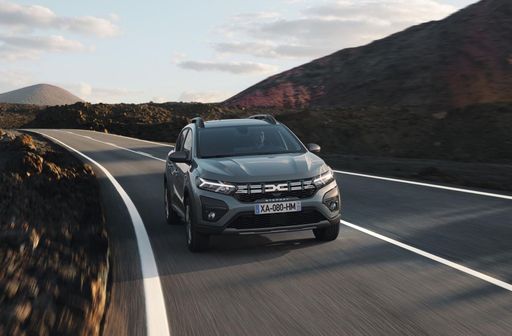 @ Dacia / Renault Group Media
@ Dacia / Renault Group Media
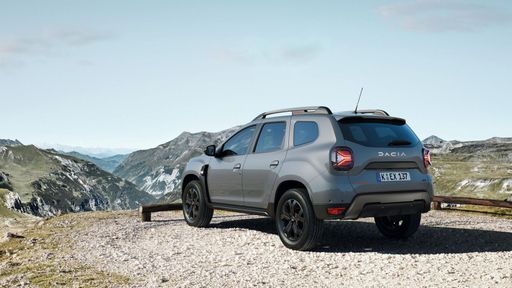 @ Dacia / Renault Group Media
@ Dacia / Renault Group Media
 @ Dacia / Renault Group Media
@ Dacia / Renault Group Media
Hyundai Bayon
The Hyundai Bayon slips neatly between city runabout and small SUV, offering surprising practicality and a fresh, confident design that stands out in urban traffic. It's an easy buy for shoppers who want smart packaging, tidy handling and a dash of personality without fuss — a sensible little crossover that makes everyday driving a bit more enjoyable.
details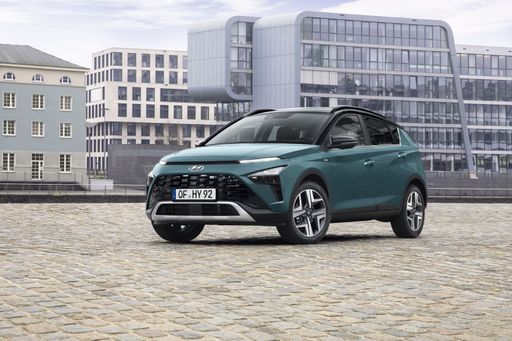 @ Hyundai Motor Company
@ Hyundai Motor Company
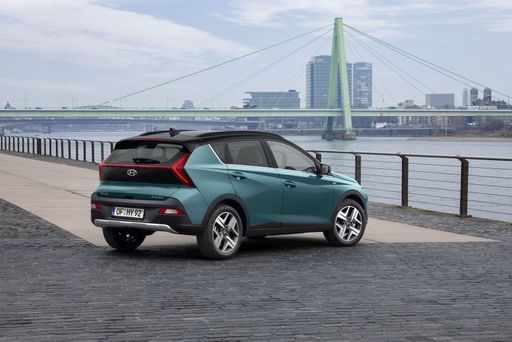 @ Hyundai Motor Company
@ Hyundai Motor Company
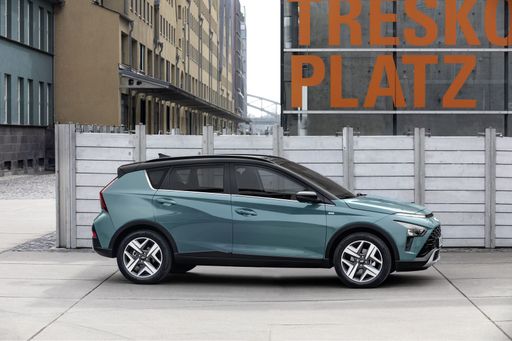 @ Hyundai Motor Company
@ Hyundai Motor Company
 @ Hyundai Motor Company
@ Hyundai Motor Company
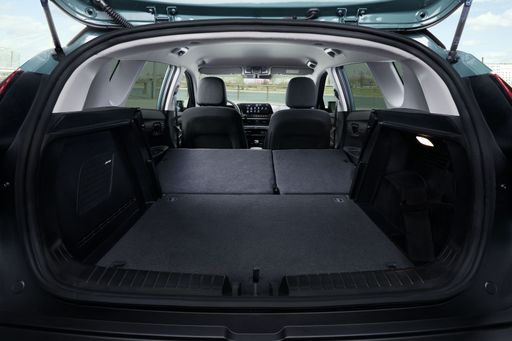 @ Hyundai Motor Company
@ Hyundai Motor Company
 @ Dacia / Renault Group Media
@ Dacia / Renault Group Media
|
 @ Hyundai Motor Company
@ Hyundai Motor Company
|
|
|
|
Costs and Consumption |
|
|---|---|
|
Price
16300 - 24900 £
|
Price
20100 - 25800 £
|
|
Consumption L/100km
4.7 - 7.5 L
|
Consumption L/100km
5.4 - 5.5 L
|
|
Consumption kWh/100km
-
|
Consumption kWh/100km
-
|
|
Electric Range
-
|
Electric Range
-
|
|
Battery Capacity
0.60 kWh
|
Battery Capacity
-
|
|
co2
107 - 124 g/km
|
co2
124 g/km
|
|
Fuel tank capacity
50 L
|
Fuel tank capacity
40 L
|
Dimensions and Body |
|
|---|---|
|
Body Type
SUV
|
Body Type
SUV
|
|
Seats
5
|
Seats
5
|
|
Doors
5
|
Doors
5
|
|
Curb weight
1377 - 1455 kg
|
Curb weight
1170 - 1195 kg
|
|
Trunk capacity
348 - 517 L
|
Trunk capacity
411 L
|
|
Length
4343 mm
|
Length
4180 mm
|
|
Width
1813 mm
|
Width
1775 mm
|
|
Height
1656 - 1659 mm
|
Height
1500 mm
|
|
Max trunk capacity
1414 - 1609 L
|
Max trunk capacity
1205 L
|
|
Payload
450 - 453 kg
|
Payload
460 - 465 kg
|
Engine and Performance |
|
|---|---|
|
Engine Type
Petrol MHEV, Full Hybrid, LPG
|
Engine Type
Petrol
|
|
Transmission
Manuel, Automatic
|
Transmission
Manuel, Automatic
|
|
Transmission Detail
Manual Gearbox, Automated Manual, Dual-Clutch Automatic
|
Transmission Detail
Manual Gearbox, Dual-Clutch Automatic
|
|
Drive Type
Front-Wheel Drive, All-Wheel Drive
|
Drive Type
Front-Wheel Drive
|
|
Power HP
115 - 158 HP
|
Power HP
100 HP
|
|
Acceleration 0-100km/h
9.4 - 11.6 s
|
Acceleration 0-100km/h
11.3 - 12.4 s
|
|
Max Speed
180 km/h
|
Max Speed
176 - 179 km/h
|
|
Torque
190 - 230 Nm
|
Torque
172 - 200 Nm
|
|
Number of Cylinders
3 - 4
|
Number of Cylinders
3
|
|
Power kW
84 - 116 kW
|
Power kW
74 kW
|
|
Engine capacity
1199 - 1789 cm3
|
Engine capacity
998 cm3
|
General |
|
|---|---|
|
Model Year
2025
|
Model Year
2024
|
|
CO2 Efficiency Class
D, C
|
CO2 Efficiency Class
D
|
|
Brand
Dacia
|
Brand
Hyundai
|
What drivetrain options does the Dacia Duster have?
The Dacia Duster is offered with Front-Wheel Drive or All-Wheel Drive.
The prices and data displayed are estimates based on German list prices and may vary by country. This information is not legally binding.
